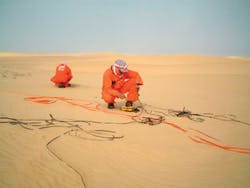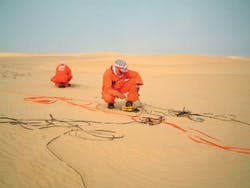A key issue facing the petroleum industry in its efforts to find and produce more oil and natural gas is the slow take-up of new technology.
Nowhere is that more so the case than in the seismic business-a high-cost sector that nevertheless has yielded technology advances with greater impact than any other in the industry’s recent history.
Seismic services contractors have undertaken the bulk of the field’s technology research and development in the past 2 decades, watching their returns on investment in promising new technologies dissipate as operators remained reluctant to adopt them. That occurs despite the game-changing impact on operators’ bottom lines in recent years of new technologies, such as 3D seismic.
Robert Brunck, president of Paris-based Cie. Générale de Géophysique (CGG), notes that industry has been inefficient in adopting new technology.
“How many years did it take for 3D technology to be widely commercially accepted after the first trial was made in the field in the ‘70s?” he asks. “It is certainly an area where a better-balanced risk sharing between operators and contractors could best advance seismic technology.”
The critical question in advancing the threshold of seismic technology then becomes: What can be done to accelerate the take-up of new technology?
Industry reluctance
Seismic service companies describe operating companies’ reluctance to readily adopt new technology as a risk aversion level that tracks oil and gas price cycles.
Per Arild Reksnes, president, Geoscience & Engineering, PGS Marine Geophysical, a unit of Oslo-based Petroleum Geo-Services ASA (PGS), notes that when oil and gas prices were lower, “companies had been more risk-averse, more reluctant to use a technology that normally demand field testing.
“At more than $100,000 a day, such long-term field testing pretty quickly gets very expensive,” he says.
Reksnes sees an increasing eagerness among operators to try new technologies, however: “They see that new technology is needed as they deal with more and more demanding targets, more complex and deeper targets.”
PGS Marine Geophysical Pres. Rune Eng thinks it incumbent upon contractors to demonstrate to operators that those companies with a more-embracing approach to common technology initiatives are those that have been the most successful.
“One of the things that we contractors need to show is that the companies that have had the most success recently are those that have invested in new technology,” he says. “Unless you see a corporate drive behind it, you’re not going to see that happen.”
For Paul van Riel, director, development and production, Fugro NV, Leidschendam, the Netherlands, accelerating the take-up of new seismic technology “simply comes down to the willingness of clients to better reward attempts at innovation.”
At the same time, however, it is important for the seismic contractor to understand the business model of the client, says Thierry Pilenko, chairman and CEO and Veritas DGC Inc., Houston.
“Our role is to help them minimize their risk,” he says. “They need something that is an ‘answer product.’”
At the same time, “we don’t live from the oil that the seismic finds. This needs to be established.
“You have to have the ability on both ends to establish, on common ground, what you can extract from the seismic image that provides an answer product.”
Collaboration vital
Collaboration between E&P companies and service companies is vital to accelerating the adoption of promising seismic technologies, says Robert Peebler, president and CEO of Input/Output Inc., Houston.
“Equally important is the need for the industry to apply creative business and financial models that are able to couple technology innovations with immediate, real-world projects,” he says. “To get seismic technology adopted rapidly, the application must also deliver on the three main points of the oil and gas companies, including improved image quality, reduced cycle time, and decreased operational costs.”
Peebler contends that for collaboration between operating companies and seismic contractors to work effectively, however, E&P companies must be willing to take on more risk in adopting new technologies.
“This includes providing capital and assets, thought-partnering on technology development projects, and an ‘E’ attitude that says some programs may be ‘dry.’”
Such collaboration could be leveraged according to an operating company’s management philosophy.
“Many technologies are not utilized by asset teams because the benefits to their particular asset team do not outweigh the risks of trying something that may not work,” says Mike Bahorich, executive vice-president, exploration and production technology, Apache Corp., Houston. “This does not mean that the benefits to the corporation are not far worth the investment, so it is often prudent to provide centralized funding to help mitigate risk at the asset team level.”
Developing a close relationship with clients is critical to ensuring that seismic services contractors understand and correctly address their challenges, notes Dalton Boutte, president, Schlumberger Ltd.’s London-based WesternGeco unit.
“This relationship also provides an avenue to effectively apply new technology as it is developed and subsequently shorten the technology adoption cycle,” he says.
Pilenko concurs, adding that Veritas makes it a point to deeply involve clients at every step in the development of new technology.
“It’s important to close the loop in an interactive way,” he says. “We need to embed our customers in our workflow and in our offices.”
Such close collaboration underpins Veritas’s business model, which is to focus on quality rather than on market share or size.
“If our market share increases, it is not because we’ve targeted market share, it’s because we’ve targeted quality, and the customers became attracted to that emphasis on quality,” he says. “This lets us work with customers who understand quality, and we can ask them, ‘What do you want in the end?’”
Boutte acknowledges that operators have grown accustomed to seeing examples of technology, quite often in or near their fields, before making buying decisions.
“It becomes difficult with high-cost technology to put this burden entirely on the service sector,” he says. “One possible solution would be early publication of successes, which would require collaboration regarding show rights.”
At the same time, it’s important to listen closely to key customers and watch what they are doing with their technology investments, says Reksnes.
“PGS recently committed to a third-generation Ramform vessel [due for delivery in first quarter 2008] because the industry has clearly embraced the need for larger streamer counts,” he points out. “The growth of the [multi-azimuth and wide-azimuth towed streamer] markets has not come about by the sole commitment of an individual service or oil company, it has come because all parties are increasingly recognizing the value of technological collaboration to solve the big challenges.”
Reducing costs
Productivity is key to reducing costs in the seismic sector, particularly with regard to cable-based land recording systems, which can account for up to 20% of the operational cost of a typical onshore survey in North America, Peebler points out.
“In order to minimize the cost of land acquisition and reduce the footprint of seismic operations, we must move to embrace a new world of land acquisition without cables,” he says. “By using cableless land acquisitions, we can improve operational productivity and leave a smaller impact on the environment.
“Additionally, the fact that many of these cableless systems also scale to very high station counts gives us the added benefit of being able to acquire fully sampled, higher-resolution data at the same time.”
Of course, the technologies that introduce new efficiencies and improve productivity stand the best chance of getting adopted.
“History shows that any technology reduces in cost as it is embraced by the mainstream,” says Reksnes. “New technology often requires massive investment, and such investment can never be maintained without a tangible return from consumers. Thus, natural selection has often erased countless innovations that initially appeared promising, but were never embraced by the mainstream.
“PGS has always pursued the ‘big picture’ in its engineering innovations-the things that really matter to the broader market, [such as] operational efficiency and flexibility, solutions that have a broad range of applications, and platforms that can have a reasonable shelf life.
“High-end acquisition solutions are only now being universally embraced-high-definition 3D, multi-azimuth, wide-azimuth towed streamer, etc.-and Ramform effortlessly accommodates them all whilst a raft of high-capacity newbuilds are being rushed into construction.”
Brunck notes that CGG is gradually moving away from using standard 3D in the Middle East, thanks to its new EYE-D offering.
“We are reaping the benefit of the step-change in the performance of the latest generation of equipment and generating different sets of seismic data, with wider azimuth and higher fold, such as we have never been able to do before,” he says. “And we are doing it for a marginal additional cost, using our patented High-Productivity Vibroseis Acquisition.”
Boutte contends that cost becomes an issue if the value of the service or product is not apparent: “If the value exceeds the customer’s expectation, then cost is not an issue.”
In the final analysis, it is equally important to share ideas as well as risks, according to Bahorich.
“It is difficult to predict where the next breakthroughs will come from, but advances often come when bright people from different disciplines and perspectives come together and share information,” he says. “As operators and contractors communicate more effectively, innovations will develop. “Sharing technology costs between operators and contractors enables ideas to flow more freely.
“Another benefit is that the contractor has a company ready to test and help refine the newly developed technology, which further reduces risk in research investments.”
Some contractors see little scope for further reducing costs relative to seismic’s value.
“Seismic is not expensive relative to the value its use creates for the clients,” says Van Riel. “In fact, seismic is now-for many years in a row-seen as the most valuable E&P technology for the operators. So I doubt if lowering the cost would significantly expand applicability.”
Pilenko concurs: “We are getting more into a new phase, where cost has become less important than innovation.”


